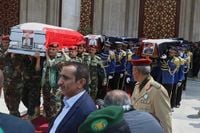On Sunday, September 7, 2025, the ongoing conflict in the Middle East took a dramatic turn when a drone, launched by Yemen’s Houthi rebels—also known as Ansarallah—struck Israel’s Ramon Airport near the southern resort city of Eilat. The attack, which was swiftly claimed by Houthi military spokesperson Yahya Saree, marked a significant escalation in the group’s campaign of solidarity with Palestinians in Gaza, as reported by The Associated Press and Al-Jazeera.
The drone targeted the arrivals hall of the airport, injuring two people. According to Israeli rescue services cited by Haaretz, a 63-year-old man suffered shrapnel wounds while a 52-year-old woman was hurt after falling during the chaos. Emergency workers quickly evacuated the injured to a hospital in Eilat, and several others who experienced panic attacks received medical care at the scene.
Operations at Ramon Airport, which primarily handles domestic flights and sits at the crossroads of Israel, Jordan, and Egypt, were halted for around two hours as authorities scrambled to assess the damage and ensure safety. The Israeli Airports Authority announced, “Following the completion of all safety and security checks, compliance with international civil aviation standards, and receipt of final approval from the Air Force — Ramon Airport has now been reopened for full operations, for both departures and arrivals.” Reuters confirmed that flights resumed later the same day.
Yet, the attack exposed vulnerabilities in Israel’s defense systems. Israeli Army Radio reported that the drone was not detected by air force detection systems—a fact that has prompted an ongoing investigation into why air raid sirens at Ramon Airport failed to activate. The Israeli military did intercept three other Houthi attack drones near the Egyptian border, but the fourth, which ultimately struck the airport, slipped through undetected.
Houthi spokesperson Yahya Saree, in a statement quoted by Al-Jazeera, declared, “A drone targeted Ramon Airport, which, by Allah’s grace, directly hit the airport and caused the airport to shut down and halt air traffic.” He also warned of further escalation, vowing that the Houthis will “escalate” their attacks against Israel in support of Palestinians in Gaza. Saree added, “The Yemeni Armed Forces assure all air navigation companies that the airports inside occupied Palestine are unsafe and will be continuously targeted.”
This latest attack is part of a broader pattern. Since the outbreak of the Israel-Gaza war in October 2023, the Houthis have repeatedly launched missiles and drones at Israel, framing their actions as acts of solidarity with Palestinians. They have also targeted commercial and military vessels in the Red Sea, further destabilizing the region. In May 2025, a Houthi missile landed near Israel’s main airport, Ben Gurion International Airport, injuring four people and leading to widespread flight cancellations. In retaliation, Israel has bombed Houthi-controlled areas in Yemen, including the destruction of Sanaa’s main airport and, more recently, an airstrike that killed Ahmed al-Rahawi, the Houthi-affiliated prime minister, along with other senior officials.
The violence has had devastating consequences for civilians. According to the Palestinian Ministry of Health in Gaza, since October 7, 2023, Israeli military operations have killed 64,368 Palestinians and injured 162,367 more—most of them women and children. The Associated Press reported that more than 64,000 Palestinians have died, and hundreds more have perished in a famine triggered by Israeli restrictions on humanitarian aid entering Gaza.
On the same day as the Ramon Airport attack, Israeli forces continued their campaign in Gaza City. Over the course of three days, troops demolished three high-rise buildings: Mushtaha Tower on Friday, Sousi Tower on Saturday, and Al-Ra’iya Tower on Sunday. Israeli officials claimed, without presenting evidence, that these buildings were being used by Hamas—a claim denied by the group. NBC News noted that Mushtaha Tower’s management insisted the building housed displaced people. Israel’s spokesperson Avichay Adraee ordered evacuations, but many Palestinians said they were too injured or exhausted to move yet again, having already been displaced multiple times. The United Nations highlighted that the alternative locations lacked basic infrastructure and supplies, and people continued to be killed even after relocating.
Tragedy struck elsewhere in Gaza as well. Medical sources at Al-Shifa Hospital reported that Israeli strikes on a school-turned-shelter killed at least 13 Palestinians, including three children, according to the AP. Al-Awda Hospital in central Gaza received five dead bodies, among them a young girl, following an Israeli strike on a U.N.-administered refugee camp. The Palestine Chronicle added that two airstrikes in Gaza City resulted in 11 deaths—two in the Al-Rimal area and nine in tents for displaced people in western Gaza City. Additional strikes killed at least four more Palestinians, including a little girl, near chalets in western Gaza City, and four others in the Sheikh Radwan area. Since dawn on September 8, 2025, 62 more Palestinians were reported killed, including 49 in Gaza City and the northern Strip.
The violence has not been confined to Gaza. On September 8, Israeli warplanes conducted intensive airstrikes on the Al-Nasr and Sheikh Radwan neighborhoods in Gaza City, as reported by Palestinian media. In central Khan Yunis, at least one Palestinian was killed and others wounded in another strike. The Palestine Chronicle also documented the execution of six alleged collaborators in Gaza City by Palestinian resistance forces, underscoring the internal tensions and the high stakes for anyone suspected of aiding Israel.
Amid the relentless violence, diplomatic efforts have continued, albeit with limited success. The United States, with former President Trump reportedly applying pressure, sent Hamas a new ceasefire proposal involving a prisoner exchange and a suspension of Israel’s planned offensive in Gaza City. Hamas stated it is ready to negotiate a deal that would include the release of prisoners, a full Israeli withdrawal, and the formation of an independent committee to manage Gaza. The group emphasized the need for binding guarantees to ensure Israel’s commitment, aiming to avoid a repeat of failed agreements in the past. Trump, for his part, issued a pointed warning: “I warned Hamas of the consequences of not accepting the deal — this is my final warning. The Israelis have agreed to my conditions, and now it is Hamas’s turn to agree. We demand the release and return of the captives from Gaza to their homes, and we all demand an end to this war.”
The conflict’s impact has reverberated far beyond the region. On September 7, thousands took to the streets in Mexico City’s Zocalo and in Damascus’s Al-Hamidiyah Market, demonstrating in solidarity with Gaza and demanding an end to the war. In London, nearly 900 people were arrested during a protest against the UK government’s ban on the activist group Palestine Action, recently designated a “terrorist organization.”
As the violence and political maneuvering continue, the attack on Ramon Airport stands as a stark reminder of how rapidly the conflict can escalate and the immense toll it continues to exact on civilians across the region.


